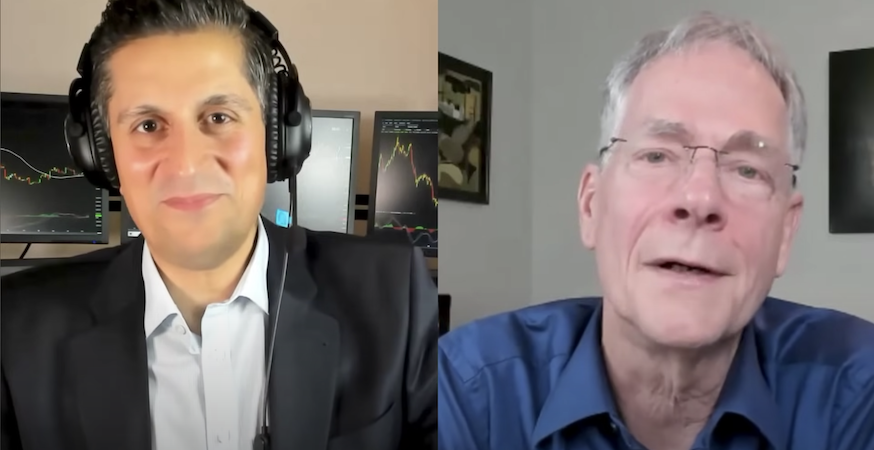Forecasts and Analysis by Robert Prechter

join us telegram A channel to stay up to date on breaking news coverage
The cryptocurrency world, and Bitcoin in particular, has been a hotbed of speculation and investment, the trajectory of which is often unpredictable. Renowned analyst Robert Prechter recently discussed this topic in an interview with known trader Alessio Rastani. He provided valuable insight into Bitcoin’s past performance and future prospects.
Prechter began by explaining how Bitcoin, initially a practical concept, evolved into a hub for investment and speculation. He emphasized the role of socio-economic causality in these changes, in which the group mentality and psychological reinforcement of traders play an important role. This transition marks Bitcoin’s transition from a practical tool to a speculative asset.
Tracing the history of Bitcoin, he noted that Bitcoin recorded phenomenal growth from just 1 cent to a peak of $70,000 (an increase of 7 million times). This growth surpassed historical speculative events such as the tulip craze of the 1600s. Prechter pointed out that during Bitcoin’s rise, it was decoupled from economic fundamentals by a wave of social sentiment and speculative trends.
According to Prechter, a critical point in Bitcoin’s timeline was January 2022, which coincided with the peaks of major stock indices such as the Dow Jones and S&P. He suggested that this marks the end of the Bitcoin bull market and is in line with broader financial market trends. Prechter’s analysis took a close look at Elliott Wave Theory, a method of predicting market movements that he has mastered over the years. This theory suggests that markets move in predictable wave patterns. Typically, there are 5 uptrends followed by 3 downside corrections.
Prechter expressed concerns about the future of Bitcoin, especially considering the limitations of the underlying blockchain technology. He warned that if a more efficient cryptocurrency were developed, Bitcoin could potentially lose its value and even fall to zero. This view casts a shadow over the future of Bitcoin, especially for those who have invested heavily in it.
Prechter’s son Elliott, who was instrumental in bringing Bitcoin to his attention, contributed to early coverage of Bitcoin in the Elliott Wave newsletter. This early acceptance, at a time when Bitcoin was valued at 6 cents, demonstrates Prechters’ foresight and innovative thinking.
Prechter’s analysis offers a sobering view of Bitcoin’s future. He suggests that Bitcoin, which is currently in a bear market, could face serious challenges in the future, especially if more efficient cryptocurrencies emerge.
News, basics or technology?
In a follow-up interview with Rastani, Prechter challenged the common belief that market movements in stocks, Bitcoin, or other financial markets are primarily driven by news and fundamental factors such as Federal Reserve actions. We critically examine these views, widely accepted by the public and promoted by the financial media.
Prechter uses insights from his books ‘The Socioeconomic Theory of Finance’ and ‘Conquering the Crash’ to argue that market movements are not as closely linked to news and fundamentals as many believe. To illustrate this point, the video presents historical examples, including the 2008 financial crisis and the 2020 market crash. Despite intervention by the Federal Reserve and the government, markets continued to decline, contradicting the belief that these institutions could control market bottoms.
This video analyzes in more detail the ‘potential mover assumption’, the idea that powerful entities such as the Federal Reserve (Fed) or the government can significantly influence market movements. Prechter emphasizes that this assumption is flawed and that market movements are often uncorrelated with important news events. Comprehensive research cited in his book supports this and shows that major market movements often occur independently of notable news.
Another important aspect discussed is the role of social climate in driving market behavior. Prechter suggests that the Fed and other institutions often react to market movements rather than causing them. This view stands in stark contrast to the popular belief that these institutions actively shape market trends.
The video also explores the psychological aspects of market behavior and discusses how emotions and sentiments play an important role. The example of the 2020 market crash shows how extreme fear and capitulation among investors and traders can lead to significant market movements, regardless of external news or intervention.
Related news
A new cryptocurrency mining platform – Bitcoin Minetrix
- Thanks to Coinsult
- Decentralized, secure cloud mining
- Get free Bitcoin every day
- Native token currently in pre-sale – BTCMTX
- Staking Rewards – APY 100% or more
join us telegram A channel to stay up to date on breaking news coverage



